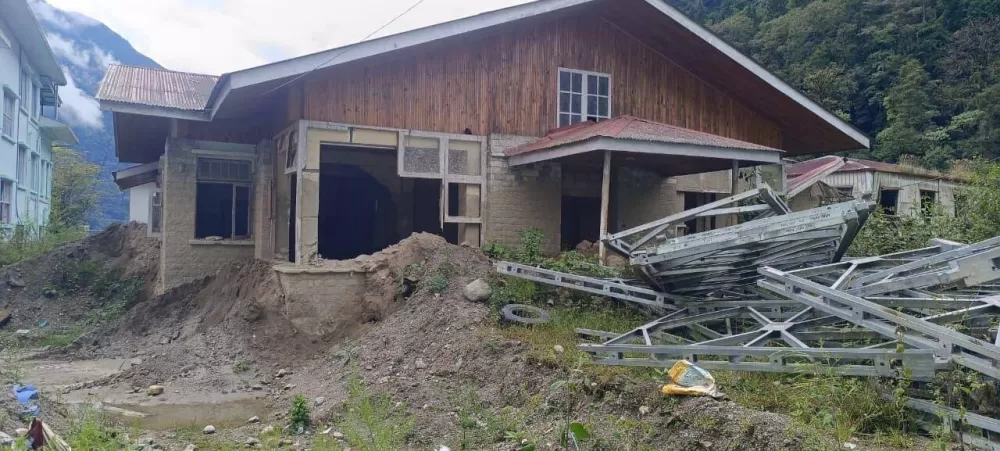The Roar of Lhonak: Two Years On, a Haunting Echo and Urgent Himalayan Warnings
Share- Nishadil
- October 24, 2025
- 0 Comments
- 4 minutes read
- 17 Views

It’s been two years, you know? Two years since that fateful day, October 3rd, when the Himalayas, beautiful and serene as they often are, truly roared. We’re talking about the South Lhonak glacial lake, nestled high up in Sikkim, and what happened there wasn't just a natural event; it was a devastating, heartbreaking message delivered with terrifying force.
A glacial lake outburst flood, or GLOF as they're grimly called, swept through the region, utterly decimating the mighty Teesta III Dam and scarring an entire river basin all the way down to Bangladesh. The loss of life, the property, the sheer disruption… it’s a memory that still chills, honestly.
But here’s the thing, and it's a bitter pill to swallow: this wasn’t entirely unforeseen.
Not really. The science had been whispering warnings for quite some time. Climate change, relentless and unforgiving, has been aggressively melting Himalayan glaciers, creating these burgeoning, unstable lakes that sit like ticking time bombs. And South Lhonak, bless its precarious heart, was a prime suspect.
Satellite imagery, even from our very own ISRO, had identified it as a high-risk zone, growing by over 60% since the early nineties. Its moraine dam, a natural barrier of loose rock and debris, just wasn’t strong enough, had a distressingly low factor of safety, they said. Yet, here we are, reflecting on a catastrophe that perhaps, just perhaps, could have been mitigated.
So, what have we truly learned, then? What lessons has this unforgiving landscape etched into our collective consciousness? For starters, monitoring, deep and constant, is absolutely non-negotiable.
We have the technology, don't we? Systems like ISRO’s Bhuvan offer incredible satellite insights, but they need to be complemented by robust, real-time ground sensors. It’s about more than just spotting a problem; it's about anticipating its breaking point.
And then there are the early warning systems, which, in truth, failed us during Lhonak.
A siren that doesn't sound, a message that doesn't reach — what good is it? We need truly reliable, truly accessible systems. Ones that aren't just technical marvels but are also deeply integrated with the communities living downstream, because they’re the ones facing the immediate brunt. They need training, they need drills, and a fundamental understanding of these risks.
Preparedness isn't a luxury; it's a lifeline.
Building practices, for once, demand a radical rethink. Are we really placing vital infrastructure, massive dams included, in the path of known and probable devastation? Perhaps we should build smarter, design for resilience, and honestly, consider avoiding high-risk zones altogether when possible.
Dams, especially those sitting precariously below glacial lakes, absolutely need to be re-evaluated, retrofitted, or perhaps, in some cases, even redesigned entirely to withstand such extreme events. It’s a costly thought, sure, but the cost of inaction, as Lhonak painfully showed, is infinitely higher.
Beyond our borders, the Himalayas are a shared ecosystem.
Doesn't it make sense, then, for countries like India, Nepal, Bhutan, and China to really ramp up their regional cooperation? Sharing data, coordinating strategies, working together on a challenge that respects no man-made lines — it's not just sensible; it’s essential. And underlying it all, always, is the undeniable truth: we must address climate change itself.
Until we grapple with the warming planet, until we genuinely commit to mitigation, these whispers of disaster will only grow louder, becoming roars that shatter lives and landscapes with increasing frequency. The Lhonak disaster isn't just a memory; it's a continuing, urgent call to action, echoing across the magnificent, yet vulnerable, Roof of the World.
.Disclaimer: This article was generated in part using artificial intelligence and may contain errors or omissions. The content is provided for informational purposes only and does not constitute professional advice. We makes no representations or warranties regarding its accuracy, completeness, or reliability. Readers are advised to verify the information independently before relying on







